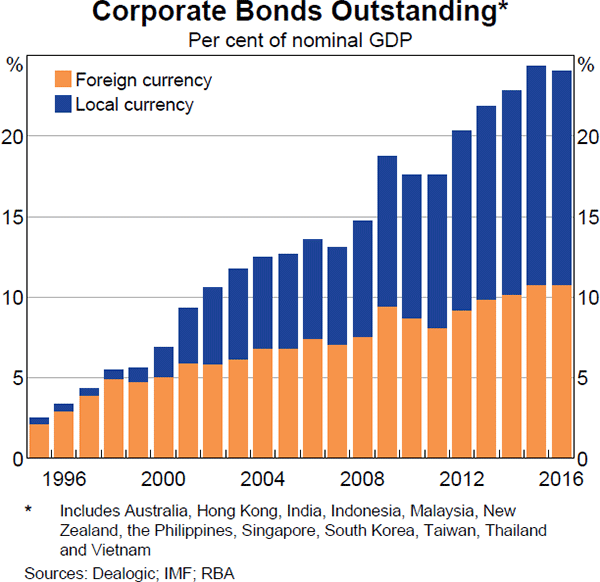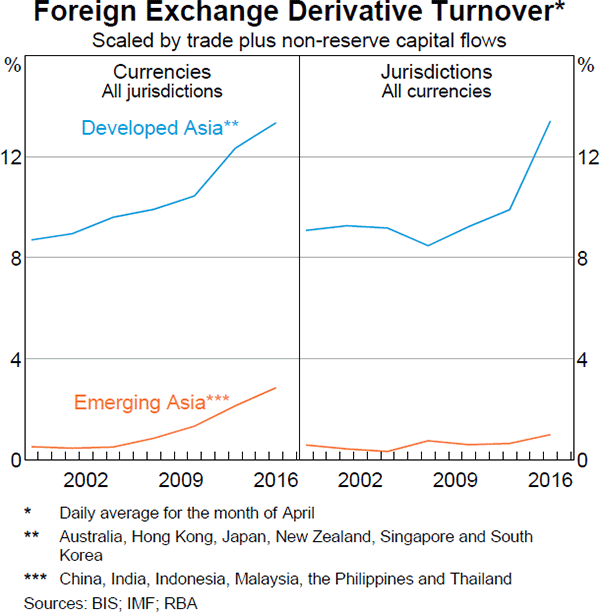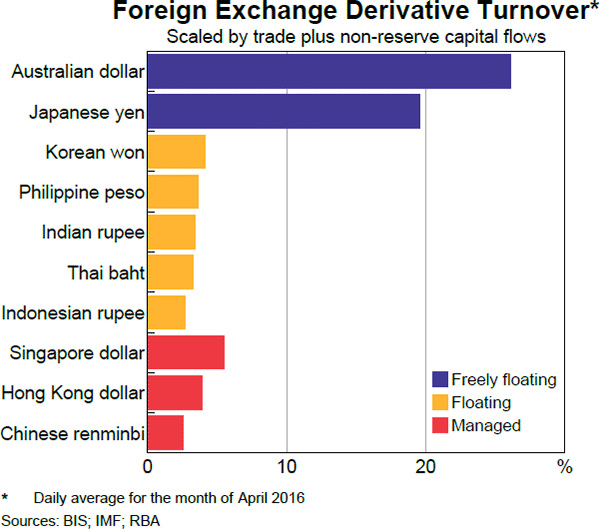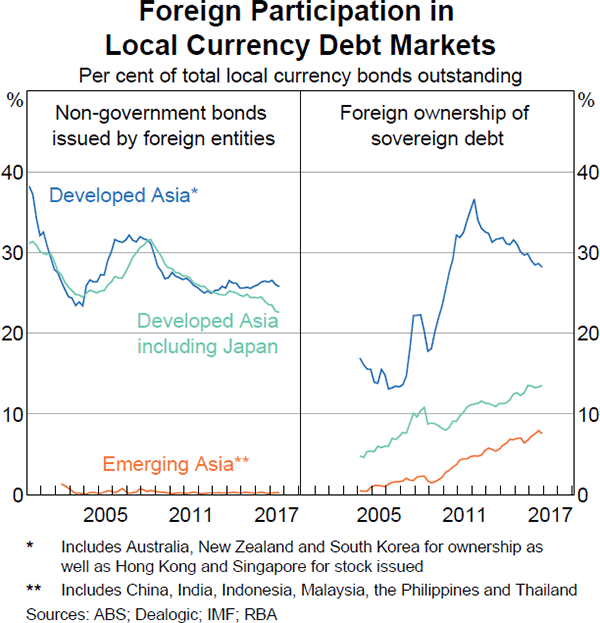Bulletin – December 2017 Global Economy Foreign Exchange Derivative Markets in Asia
- Download 1.31MB
Abstract
Activity in foreign exchange derivative markets in Asia has increased in recent years, along with greater incentives to hedge exchange rate risk. But these markets are more developed for the currencies of advanced Asian economies than emerging Asian economies. Foreign exchange derivative markets also tend to be deeper for Asian economies that are more integrated into global financial markets and have flexible exchange rates.
Introduction
Many Asian entities – including Australian entities – have exposure to exchange rate risk. For entities with foreign currency assets, liabilities or trade exposures, changes in exchange rates can alter the domestic currency value of their balance sheets or cash flows. In this way, large changes in exchange rates can potentially affect economic activity and even financial stability. Firms can limit exchange rate risk by hedging with financial instruments known as derivatives.[1] (Exchange rate risk can also be hedged ‘naturally’; for example, a firm with US dollar income may take out a US dollar loan in preference to a loan in local currency terms.) A key factor in a firm's ability to hedge exchange rate risk is the availability and cost of foreign exchange derivatives in financial markets. Liberalisation of financial markets and economies more generally may also prompt demand for these products – and thereby spur further development of derivative markets – as firms manage the exchange rate risk associated with a rise in cross-border flows of capital and more flexible exchange rate regimes.
This article explains the importance of hedging exchange rate risk for economies in the Asian region, including Australia. It examines the significant variation with respect to the development of foreign exchange derivative markets across Asia. It also considers a broad set of factors that are likely to be associated with the development of foreign exchange derivative markets, including a country's exchange rate regime, degree of integration with international financial markets and extent of financial market development.
The Importance of Hedging Exchange Rate Risk
The importance of hedging exchange rate risk has been evident during the Asian financial crisis of 1997–98 and subsequently. In the lead-up to that crisis, exchange rates were relatively stable because they were heavily managed by the local authorities. This coincided with a build-up of foreign currency debt in these economies, and the exchange rate risk associated with these loans went largely unhedged (Stevens 2007).
When the exchange rates of those economies depreciated sharply during the Asian financial crisis, the repayments on the foreign currency loans increased significantly when measured in domestic currency terms. In many instances, borrowers were unable to repay their debts. This contributed to financial instability throughout the region.
Following the Asian financial crisis, exchange rates in the region – including in Thailand, Indonesia and South Korea – became more market determined. For some exchange rates, volatility has been higher than it was before the Asian financial crisis, thereby increasing the importance of sound exchange rate risk management. Cross-border financial flows declined substantially during the Asian financial crisis, but recovered and continued to grow (notwithstanding a temporary decline during the global financial crisis). In aggregate, gross capital flows between each Asian economy and the rest of the world have risen significantly over the past decade or so even though global capital flows have declined (Graph 1). Gross trade in goods between each Asian economy and the rest of the world has also risen as a whole over the past decade, faster than the increase in global trade. This has coincided with an increase in Asian economies' share of global trade in goods, driven by China, which increased its share of global trade from 5 per cent in 2005 to around 10 per cent in 2016. A sizeable share of these capital and trade flows are denominated in foreign currency, such that the incentive to hedge against the exchange rate risk increases as these flows grow over time.
Financial systems in the region continued functioning during the global financial crisis in 2008–09 despite significant volatility in exchange rates during that period (Ryan 2016). To some extent this was because exchange rate risk management had improved since the Asian financial crisis. But concerns about exchange rate risk remain. These largely relate to the steady increase in the extent of borrowing by corporations that is denominated in foreign currencies (see, for example, IMF (2015)). The stock of foreign currency bonds issued by corporations in the region has grown faster than GDP in recent years (Graph 2). This is in contrast to the official sector, as most Asian governments have little reliance on foreign currency funding.


Considerable growth in Asian foreign exchange and interest rate derivative markets since the early 2000s has enabled corporations to better manage the risks associated with foreign currency exposures. The existence of natural hedges, such as foreign currency export income, also partly addresses concerns about corporations' foreign currency borrowing. However, derivative markets remain small and relatively underdeveloped in some economies, and much of the exchange rate risk associated with foreign currency exposures is likely to remain unhedged.
The Development of Foreign Exchange Derivative Markets in Asia
The rest of this article draws heavily on the results of the 2016 Bank for International Settlements (BIS) Triennial Central Bank Survey of Foreign Exchange Markets. This survey captures global foreign exchange derivative activity by currency across all markets, which provides a broad measure of the ability of market participants to hedge exchange rate risk. This is particularly important for currencies where a significant proportion of activity occurs outside of the domestic market. Another measure used in this article captures foreign exchange derivative activity denominated in all currencies in a given market. This provides one indication of the extent of domestic financial development and the availability of foreign exchange derivatives in a given location.
For most Asian currencies, the value of foreign exchange derivative activity has grown substantially over the past 15 years or so (Graph 3).[2] Part of this rise in activity is consistent with an increase in the gross capital and trade flows between each Asian economy and the rest of the world. These flows provide some indication of the extent of transactional demand for foreign exchange hedging, given that a sizeable share of capital and trade flows are denominated in foreign currencies.[3]

Even when scaled by a measure of transactional demand, foreign exchange derivative activity in Asian currencies has increased over the past decade or so. While these types of financial markets have grown in aggregate since the early 2000s, most of this growth has occurred in the currencies of more financially developed economies in the region, such as the Japanese yen and the Australian dollar. Foreign exchange derivative activity in emerging Asian currencies accounts for only a small share of activity in the region when scaled by the corresponding estimate of transactional demand for these currencies. In addition to a higher value of turnover, developed derivative markets typically also feature more sophisticated contracts (Upper and Valli 2016).
One Asian currency that has experienced rapid growth in foreign exchange derivative activity in recent years is the Chinese renminbi. Growth in renminbi foreign exchange derivative activity has been underpinned by Chinese financial market liberalisation. This includes the exchange rate and domestic interest rates gradually becoming more market determined (Ballantyne et al 2014). A range of initiatives designed to partly liberalise the Chinese financial and capital accounts have also expanded access to Chinese financial markets and encouraged Chinese capital flows to the rest of the world in recent years.
A substantial proportion of the rise in renminbi-denominated foreign exchange derivative turnover has occurred outside of China, largely in Hong Kong and Singapore (Garner, Nitschke and Xu 2016). Growth in these larger offshore foreign exchange markets is likely to have been encouraged by the Chinese authorities' efforts to internationalise the renminbi together with the lower trading costs available in these markets. Within China, foreign exchange derivative activity remains small relative to trade and capital flows.
A large proportion of foreign exchange derivative turnover denominated in Australian dollars, Japanese yen and New Zealand dollars is also conducted outside of the domestic market or consists of cross-border transactions between foreign and domestic entities (rather than conducted between domestic entities). This is facilitated by these currencies being fully convertible, that is, the domestic currency can be easily exchanged for a foreign one. The high degree of capital account openness and flexible exchange rate regimes in these jurisdictions is also likely to encourage offshore derivative activity (see further detail below). Together, these factors may encourage cross-border financial flows denominated in domestic currency and the movement of foreign exchange trading to the most cost-effective locations.
What Factors Drive the Development of Foreign Exchange Derivative Markets?
A broad set of factors, including a country's degree of integration with international financial markets, exchange rate regime, and extent of financial market development, are likely to be associated with the development of foreign exchange derivative markets. However, as these factors are all inter-related, it is hard to distinguish the role of any one factor by itself.
More financially open economies are likely to have a larger volume of cross-border capital flows and more free-floating (and therefore more volatile) currencies, and thus a greater demand for foreign exchange derivatives for hedging purposes.[4] A free-floating currency, such as the Australian dollar, is market determined and therefore tends to be more volatile than a managed currency, such as the Hong Kong dollar. This volatility creates uncertainty around fluctuations in the value of exposures denominated in floating currencies, which generally leads to a greater prevalence of hedging. The additional uncertainty associated with movements in free-floating exchange rates may also encourage speculative position-taking in foreign exchange derivative markets. Consistent with this, Australian foreign exchange derivative markets grew quickly following the floating of the Australian dollar (Debelle 2006).[5]
Two common measures of financial openness are the stock of a country's total external liabilities and assets, and the gross flow of capital between an economy and the rest of the world (Quinn, Schindler and Toyoda 2011; Lane and Milesi-Ferretti 2006). Asian economies with larger external financial positions, when measured as the stock of external assets and liabilities relative to GDP, tend to have higher levels of foreign exchange derivative activity in their currencies relative to GDP (Graph 4, left panel). This relationship is still positive, though weaker, when openness is measured using a country's gross capital flows relative to GDP (Graph 4, right panel). However, there is no evidence of a relationship between changes over time in these variables and the growth of foreign exchange derivative markets. Capital flows are more volatile than the stock of a country's external assets, which could make it difficult to identify temporal relationships with any degree of precision (Quinn, Schindler and Toyoda 2011).

There is also some evidence of a positive association between a given Asian currency's level of foreign exchange derivative activity, when scaled by an estimate of transactional demand, and its exchange rate regime. The level of foreign exchange derivative activity denominated in freely floating currencies, such as the Australian dollar or Japanese yen, is much higher compared with those currencies that have managed exchange rate regimes, such as the Singapore dollar (Graph 5).[6] As discussed above, this result is consistent with the additional exchange rate volatility associated with a floating exchange rate providing the incentive for hedging and position-taking in a currency.

There is little evidence of a positive association between foreign exchange derivative activity in a given Asian currency and the level of exchange rate volatility. This is true when measured over various time horizons or in terms of changes in these variables. Market participants' expectations for volatility, rather than observed volatility, may be driving this result. More specifically, managed exchange rates may lead market participants to expect a lower level of exchange rate volatility and discourage hedging activity, although realised volatility may be quite different.
The variation in foreign exchange derivative market development across Asian currencies is also consistent with developed economies in the region generally having more developed financial markets and regulatory frameworks, stronger institutional settings and greater foreign participation in their domestic bond markets. Indeed, McCauley and Scatinga (2011) find evidence that countries with a higher level of per capita economic activity tend to have a higher amount of foreign exchange turnover for the purposes of financial trading, rather than for the hedging of exchange rate risk associated with trade or capital flows.
Foreign participation in local currency bond markets can foster the development of foreign exchange derivative markets. The ability to insure against exchange rate risk depends on the existence of two willing parties to a derivatives trade. Consider the case of Australia. Australian banks diversify their funding sources by raising some of their funds in a foreign currency. They then swap these back into Australian dollars for the purpose of extending loans in Australian dollars to Australian borrowers. In order to do so, there must be a party that wants to participate in the other side of this foreign exchange swap transaction. This includes foreign entities that have issued debt in Australian dollars (that is, via the so called ‘Kangaroo’ market), but ultimately want funding in the foreign currency.
However, potential parties to foreign exchange derivative trades in emerging Asian currencies are still limited. The available data suggest there has been a pick-up in foreign issuance of local currency non-government bonds in emerging Asian currencies, driven by bonds denominated in Chinese renminbi. However, as a share of non-government bonds outstanding, the stock of these bonds remains low compared with the share for developed Asian economies (Graph 6, left panel).
Similarly, the share of emerging Asian economies' local currency sovereign debt that is held by foreign investors has also increased over time, but remains below the share for developed Asian economies (Graph 6, right panel). Although foreign investor participation remains relatively modest in emerging Asian economies, an increase in foreign holdings of local currency government debt has tended to be associated with growth in foreign exchange derivative turnover. Despite this, liaison by the Asian Development Bank suggests that many non-resident investors in local currency bond markets choose not to hedge their exchange rate risk (Asian Development Bank 2015).
Other factors, such as trade in goods and services between an economy and the rest of the world, may also be associated with foreign exchange derivative market development. International trade gives rise to exchange rate risk and thus hedging transactions. While the evidence for this is mixed (see Upper and Valli (2016)), trade flows may be an important determinant of foreign exchange derivative activity at lower levels of national income.

Conclusion
Activity in Asian foreign exchange derivative markets has increased in recent years, along with greater incentives to hedge exchange rate risk. These markets are more developed for the currencies of advanced economies in the Asian region, when compared with those of emerging economies. There is some evidence that floating exchange rate regimes and financial markets that are more integrated with the global economy are associated with larger foreign exchange derivative markets. Country experiences also demonstrate that foreign exchange derivative activity need not occur within the domestic market.
The development of foreign exchange derivative markets can usefully be considered in the context of broader financial market development. As emerging Asian economies grow and their financial systems develop, foreign exchange derivative activity in these currencies is likely to increase. Willing parties are essential for each foreign exchange derivative transaction. In particular, the costs need to be low enough to be mutually beneficial. Irrespective of how they develop, highly liquid and low-cost derivative markets, combined with adequate risk management practices, can help to limit the build-up of systemic risk.
Footnotes
The author is from International Department and would like to thank Ellana Brand and Melissa Wilson for their help with this work. [*]
For an update on foreign currency hedging in Australia, see Berger-Thomson and Chapman (2017). [1]
Foreign exchange derivative activity data are not available for the Indonesian rupiah, Malaysian ringgit, Philippine peso and Thai baht. Total foreign exchange activity (that is, including spot activity) is used as a proxy for foreign exchange derivative activity in these currencies. This represents an upper bound for foreign exchange derivative activity in these currencies. [2]
Much of the analysis in this article is based on foreign exchange derivative activity scaled by gross cross-border trade and capital flows. One alternative scaling measure is nominal GDP; using this measure does not materially change the results. [3]
The IMF classifies exchange rate arrangements into various categories. Floating exchange rates are largely market determined without a prescribed target, but intervention is conducted occasionally. Free-floating exchange rates are floating rates but intervention is rare; limited to three instances of intervention over six months. For the purpose of this article, we classify all other IMF categories, which are less market determined, as managed arrangements (for example, an exchange rate pegged to the US dollar). This article applies the exchange rate classification from the 2016 IMF Annual Report on Exchange Arrangements and Exchange Restrictions. [4]
This also coincided with the liberalisation of Australia's capital account and domestic financial markets. [5]
These results are broadly consistent with those derived from a broader sample of advanced and emerging economies' currencies. [6]
References
Asian Development Bank (2015), ‘Report on Facilitating Foreign Exchange Risk Management for Bond Investments in ASEAN+3’, August. Available at <https://www.adb.org/sites/default/files/publication/173014/facilitating-fx-risk-management-asean3.pdf>.
Ballantyne A, J Hambur, I Roberts and M Wright (2014), ‘Financial Reform in Australia and China’, RBA Research Discussion Paper No RDP 2014–10.
Berger-Thomson L and B Chapman (2017), ‘Foreign Currency Exposure and Hedging in Australia’, RBA Bulletin, December, pp 67–75.
Debelle G (2006), ‘The Australian Foreign Exchange Market’, Address to Insto's Foreign Exchange Conference, Sydney, 17 November.
Garner M, A Nitschke and D Xu (2016), ‘Developments in Foreign Exchange and OTC Derivatives Markets’, RBA Bulletin, December, pp 63–74.
IMF (International Monetary Fund) (2015), ‘Global Financial Stability Report: Vulnerabilities, Legacies, and Policy Challenges: Risks Rotating to Emerging Markets’, available at <http://www.imf.org/external/pubs/ft/gfsr/2015/02/pdf/c3_v2.pdf>, October, World Economic and Financial Surveys, Washington DC.
Lane P and GM Milesi-Ferretti (2006), ‘The External Wealth of Nations Mark II: Revised and Extended Estimates of Foreign Assets and Liabilities, 1970–2004’, IMF Working Paper No WP/06/69.
McCauley RN and M Scatinga (2011), ‘Foreign Exchange Trading in Emerging Currencies: More Financial, More Offshore’, BIS Quarterly Review, March, pp 67–75.
Quinn D, M Schindler and AM Toyoda (2011), ‘Assessing Measures of Financial Openness and Integration, IMF Economic Review, Vol. 59, No 3.
Ryan C (2016), ‘The Development of Hedging Markets in Asia’, Address to The 7th Pan Asian Regulatory Summit, Hong Kong, 8 November.
Stevens G (2007), ‘The Asian Crisis: A Retrospective’, Address to The Anika Foundation Luncheon Supported by Australian Business Economists and Macquarie Bank, Sydney, 18 July.
Upper C and M Valli (2016), ‘Emerging Derivatives Markets?’, BIS Quarterly Review, December, pp 67–80.